Netted irises: description, varieties, planting and care

Net irises are the favorites of gardeners who prefer to grow perennial bulbous flowers. These are aesthetic plants that are perfect for decorating a small flower garden. To grow beautiful flowers on the site, you need to study in more detail the varieties of mesh iris and the features of caring for it.

Description
Other names for the species are iridodictium or reticulum. The culture is a small bulbous plant that grows to a height of no more than 17 cm.
The specimen is appreciated by gardeners for its early flowering - in the spring you can see pretty neat colorful buds with a diameter of 6-8 cm.
The color of the petals may be different depending on the speciesthere are even varieties with attractive streaks and petal spots.

And also boxes with seeds are formed on the bushes. It is customary to take them off in the summer and plant them right away. As soon as the summer heat sets in, the plant will stop blooming, and its aboveground part will dry out. The culture is not particularly demanding to care, the plant forms 3-4 new bulbs per year. Externally, the planting material has a length of 3-4 cm and a diameter of 1.5-2.5 cm, on the surface there is a reticular fibrous shell, for which this species got its main name.

Varieties
Let's consider the most popular varieties.
- "Harmony". The cultivar has large bulbs with thick scales that protect against freezing. There are several varieties that differ from each other in the color of the petals. Harmony species can have red, orange, purple, yellow, white or blue flowers. Two-tone options are available.
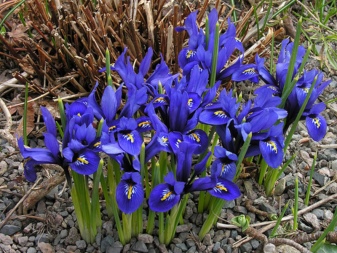

- "Katharina Hodgkin". The most popular variety in florist circles. In diameter, its flowers reach 10 cm, and the petals are cast in a delicate blue tint. And also the buds have a pleasant aroma. This variety tolerates waterlogged soils and is resistant to temperature fluctuations. Flowers can be grown in one area for 3-5 years, and then they will require transplanting.

- "Alida". This flower is distinguished by delicate blue petals with yellow and white blotches. It is also valued for its easy and quick reproduction in the garden.

- "I Catcher". The buds of this variety are decorated with a light cream base, blue stripes are visible on the upper petals, and yellow lines and dark blue blotches on the lower ones.
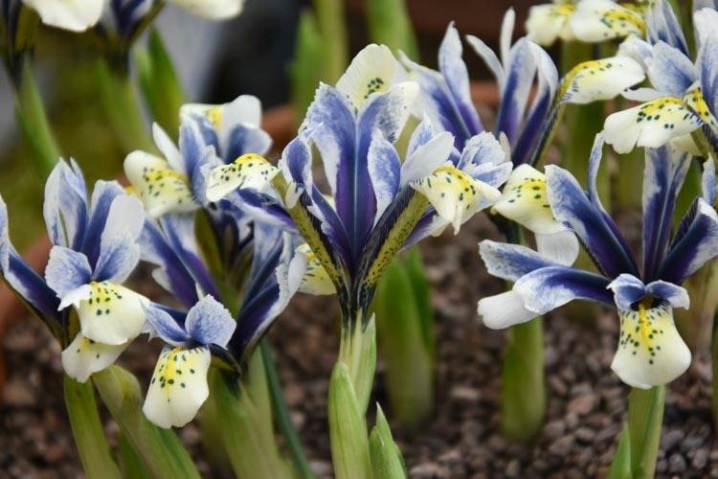
- Blue Note. A very aesthetic variety with dark blue upper petals and expressive black lower petals with white and black-blue blotches.

- Paulina (Pauline). One of the most beautiful species with purple flowers. The diameter of the buds is 9 cm. The peduncle reaches a height of 25 cm, and the leaves are distinguished by a rich green color and an elongated shape. The bulbs are ovoid. It is recommended to plant the variety no earlier than mid-September - then it will bloom on time. This species can be grown without transplanting for up to 5 years.

- Purple Jam. The diameter of the inflorescences in the presented variety can be 15 cm, the color of the petals is lilac-violet, and the lower petals are cast black. How the flash looks on the dark petals is a white brushstroke. This variety is often used for bouquet arrangements.
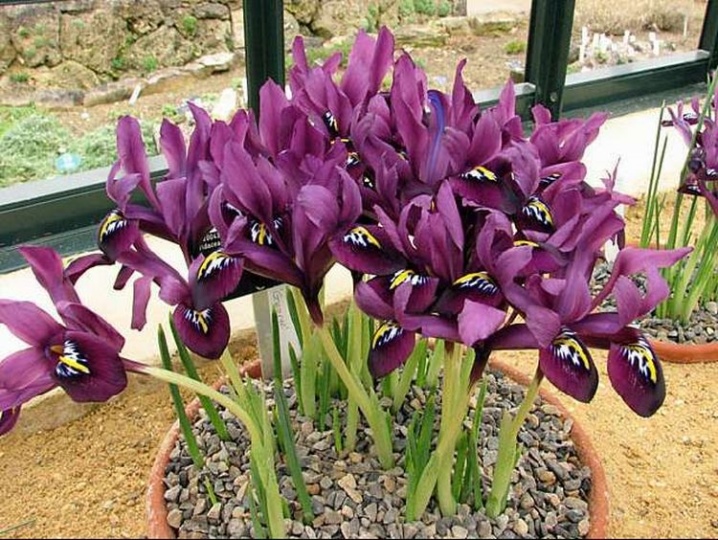
- "Pixie". It is the smallest variety of the netted variety. The peduncle does not grow more than 15 cm, and the flower itself has a maximum size of 8 cm. The color of the petals is purple with a yellow stroke.

- Fabiola. This variety is a novelty. It has blue petals with a neat white spot.It belongs to the dwarf - no more than 15 cm in height. This variety is characterized by a sweetish aroma. After flowering, the narrow leaves can reach a length of 40 cm, but by the end of spring, during the dormant period, they will disappear.
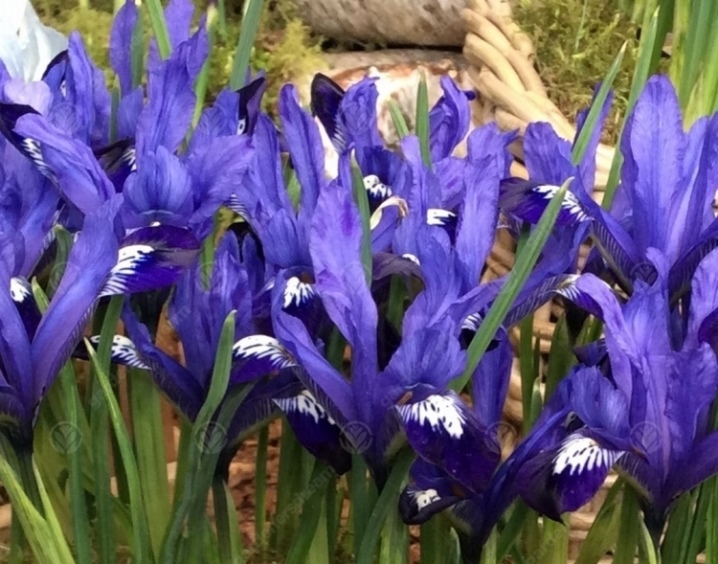
How to plant?
Reticulated species are usually planted in September or early October. If planting is carried out in spring, then flowering should be expected no earlier than a year later. First of all, you should choose a suitable site. An open, well-lit flower bed is suitable for culture. It is better if it is an elevated area or a place that excludes stagnant water. Excess moisture can provoke the development of fungal or putrefactive ailments.
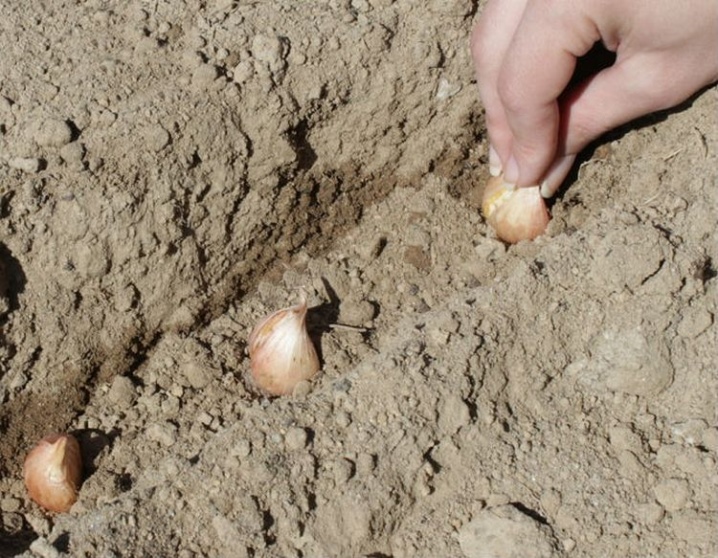
Choose sandy light soil as soil. Dig it up in advance and loosen it up. If the composition of the soil has increased acidity, then the addition of chalk, lime or ash is allowed. Ordinary garden soil can be diluted with sand and peat. Drainage is carried out if necessary.

Pay special attention to the planting material. These should be healthy, intact bulbs with no signs of damage. Before planting, they are soaked for 40 minutes in an antifungal agent or a solution of potassium permanganate. Next, the seedlings are dried and deepened into the ground by 10 cm; the soil must be well moistened before planting.
The recommended spacing between specimens is 3-5 cm.
If the planting is done correctly, then young plants will root in the soil even before the first frost, in the spring the owner of the site will be able to admire the charming bright flowers and enjoy their fragrance.

How to care?
Worth listening to to the following recommendations for the care of the presented crop:
- during the formation of the stem and buds, the culture needs careful watering; at the same time, it is better to divide the water into portions and supply the plant with moisture little by little, but very often - such measures will reduce the risk of rotting of the bulbs;

- as soon as the flowering period is over and yellowness appears on the leaves, the bulbs need to be dug up and dried well; this procedure will avoid the appearance of ink stain; if dark spots are noticeable on the bulbs, then the sample must be disposed of, otherwise, upon replanting, it will infect healthy adjacent bulbs;
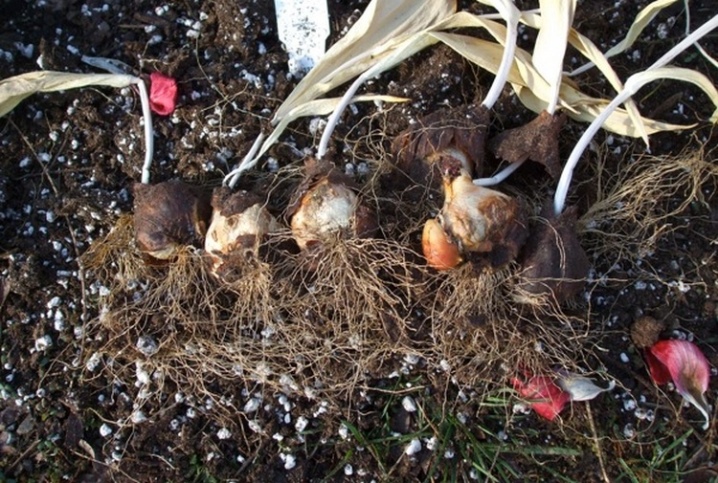
- dug out healthy specimens are recommended to be stored in a cool and dry place until the planting period; this manipulation will provide the plant with rest, allow it to grow stronger before the season; if you do not dig up the bulbs after flowering, then they are more likely to die during the summer rains or be crushed;

- as soon as the spring warmth comes, the winter shelter can be removed and the planting site abundantly moistened.

Use in landscape design
It is better not to plant the crop in a large area due to its early flowering. Gardeners use different varieties as garden compositions, when decorating alpine slides and flower beds. Net irises can be planted in the foreground and can also be used as a pot plant. When drawing up flower arrangements in a flower bed, one must be guided not only by aesthetic taste, but also take into account the preferences of the representatives of the flora themselves. For example, irises love soil with a neutral or slightly acidic environment, so their potential "neighbors" should also love such soil. Iridodictiums get along well with other small flowers, for example, crocuses or scyllas. And it is also possible to plant next to decorative perennials with a compact root system.


For information on how to plant irises correctly, see the next video.







































































































The comment was sent successfully.